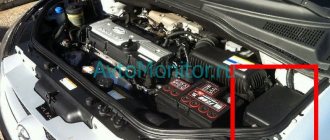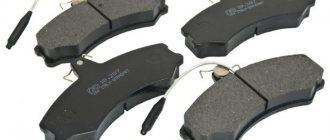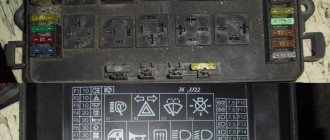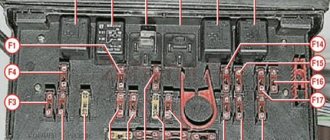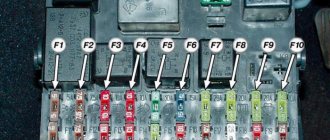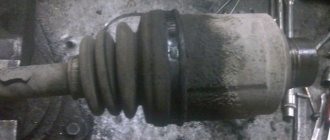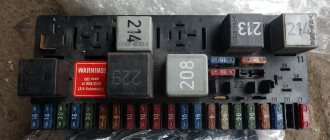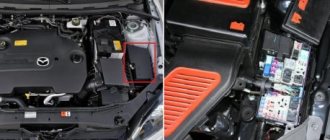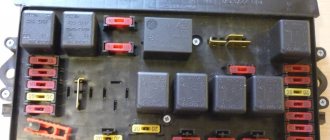What is a fuse?
The element of the electrical circuit that protects the microwave oven from all kinds of surges in the network and burns out first is called a fuse. There are so many types, they differ only in the way they are triggered. Microwave ovens are equipped with fusible fuses that contain a metal filament. The principle of operation is to heat the filament and melt it as the current increases. This preserves the functionality of other elements. Thus, at high voltage it burns out and requires replacement for further operation of the device. The following fuse is installed on Samsung - Samsung 5kv 0.65 +A.
Samsung microwave fuse
Why are they burning?
I already answered above, let me list them point by point so that it sticks in my head:
- Short circuit
- Increasing the current strength in the network
- If you plug in a device that is not designed for the network
That's all the reasons. Often the cigarette lighter fuse burns (read how to replace it here). Because we don’t include anything in it - video recorders, radar detectors, navigators, kettles, heaters, etc. They overdid it with something, and it all burned out, that is, it saved your network from damage.
Correct wiring, or how to avoid replacing a fuse
The fact that occasionally a car's fuses will blow is not a cause for serious concern. A reason to think arises when such a situation repeats itself too often. In order to understand that the fuse has burned out and needs to be replaced, you do not need to be an expert - in this situation, those electrical appliances for which the damaged “protector” is “responsible” stop working.
For an experienced driver, the question “how to find out if a fuse has blown in a car” is not difficult, but to understand why it burns out, especially the same one, is a more difficult task. The first step is to check all the wiring in the engine compartment, or rather the integrity of its insulation.
You should be especially careful with the onset of frost - some types of automotive insulation simply cannot withstand, crack and cause a short circuit, which is the answer to the question of why fuses in a car burn out. Naturally, finding problem areas in the wiring requires a lot of work, since the breakdown can be masked by dirt, and it is not always possible to find it right away.
There can be several reasons for a fuse blowing: The first is damage to any electrical component or element of the wiring, as well as the wiring itself as a whole, which causes a short circuit. As a result of this damage, the current flows along a shorter path, which has a significantly lower . According to Ohm, a decrease in the resistance of a section of a circuit leads to a proportional increase in current strength. As a result, the fuse link in the fuse burns out, the electrical circuit is opened and a short circuit is prevented. The second is a current surge (overload). Occurs when something that is driven becomes jammed. At the same time, an increased current load appears inside itself, which the fuse takes on and burns out, protecting the electrical circuit. The third is the installation of a fuse taken without the proper reserve. In this case, the current that blows the fuse (the melting current of its shell) is only slightly higher than the normal current for a given electrical circuit. In this case, a small increase relative to the nominal is enough for the fuse to blow. Fourth, poor contact between the block and. In this case, the fuse not only burns out, but its body along with the block also melts. This often occurs when using low-quality fuses, which do not burn out, but melt, causing the contacts to burn out and the plastic of the fuses to melt. This is a very serious defect, as it can damage the entire fuse block. The fifth is the loss of the available fuse supply. This happens over time, when the fuse part of the fuse forms areas with a smaller cross-section and can be a consequence of heating, vibration, shock loads, as a result of which the cross-section of the fuse part decreases so much that it cannot withstand and burns out with a certain increase in current. It is noticed that the fuses Most often they burn out not during, but at the moment the electrical circuit is turned on. This is explained by the fact that metal threads of electrical wiring increase their resistance when heated. At the moment of switching on, the threads are not heated, so their resistance is low, and the flowing current exceeds normal. As it warms up, the resistance increases and the current decreases. Obviously, at the moment of switching on, an inrush of current occurs, which exceeds the current consumed in normal mode. In rare cases, fuses can blow when the electrical circuit is turned off. This happens because at the moment of switching off, extra currents develop, which blow out the fuse. This phenomenon is more typical for those sections of the circuit that contain semiconductor elements.
Identifying a faulty fuse
Cars come with one block and two fuse blocks, usually one is located in the engine compartment, and the second is under the dashboard to the right of the driver.
The block located in the engine compartment is responsible for equipment related to the direct operation of the engine and everything that works together with it, as well as for external lighting.
As you might guess, the fuse box located in the cabin is responsible for all the equipment located in the cabin, including the instrument panel and lighting.
Often, on the covers of these blocks there is an explanation of which vehicle equipment a certain fuse belongs to. It is also possible to determine at random by examining each fuse for its malfunction; in this case, the main thing is to determine in which block it is located.
The fuse in the microwave has blown
A clear sign indicating such a breakdown is the complete absence of visual and noise effects (the display does not light up, nothing buzzes). This indicates a failure of the main fuse in the power supply.
There can be up to three of them in total.
The second is located in the high-voltage circuit and protects the supply transformer from overloads from the magnetron.
The third are equipped with furnaces with electronic control units, which are powered, as a rule, through a separate branch.
Why do fuses blow in a microwave?
There can be many reasons. Let's look at some of them.
Malfunction of individual parts
To prevent the device from being turned on with the door open, protection is provided.
Its role is played by microswitches.
The door has pushers that bring them to the desired position. If these parts do not work correctly, the fuse-link may burn out.
Contact disappeared
Malfunction of switches is often caused by deposited grease, burning or breaking of connecting contacts, and abrasion of the mechanical pusher.
Closure
Short circuit of the power transformer is another cause of the defect.
Burnout also causes a malfunction of the magnetron or capacitor of the high-voltage circuit.
What to do if the fuse is broken?
What to replace
Instead of a damaged part, you can only install an element that has the same data and capabilities.
You can buy it in radio parts or electrical goods stores. They are marked according to the maximum available load current.
If you are not sure that you will select the new part correctly, you can contact a specialist. It is guaranteed to return all functions to the kitchen appliance.
How to fix the problem yourself
You can try to repair the device yourself, saving time and money.
In this case, a minimum set of tools and basic knowledge of electrical engineering are required.
- If you decide to fix the problem yourself, then first of all you need to remove the back cover using a screwdriver.
- After removing the protective cover, remove the fuse. It is usually located at the base of the power wire.
- If obvious signs of burnout are visible, you will have to install another one.
- If there are no visual signs, test the continuity with a multimeter.
- After replacement, check the operation of the oven.
Other troubleshooting methods
If a repeated burnout occurs, you need to pay attention to the serviceability of the switches described above. First of all, make sure that they are pressed all the way by the pushers.
It happens that the base bends and the elements are not included. If necessary, adjust the location. It is worth making sure that the position of the push button instantly changes when opening the door. A slight delay caused by fat deposits melts the insert, which affects the performance of the device. The next possible reason is the contact burning and sticking inside. To eliminate the cause, cleaning or replacement with a new one is required. The parts are easy to understand, so it won’t be difficult to decide what to do. If the main fuse is intact and the microwave does not work, you need to check the insert in the high-voltage circuit. It is located in a closed plastic holder. We extract and call her. If a malfunction is detected, we replace it with the same one, taking into account the current strength. If the equipment still does not work, you need to check the insert in the control unit circuit or replace it with a known intact one. The lack of voltage here makes it impossible to start the microwave oven.
Read also: How to check how many amperes are in a battery with a multimeter
INDEPENDENT REPLACEMENT OF FUSES
Replacing a burnt-out device with your own hands is a matter of just a few minutes. Naturally, in order to avoid subsequent replacement of the entire fuse box, this simple manipulation should be taken with full responsibility. After accurately identifying the source of the problem, replacing the fusible protector should begin with selecting a new one that exactly matches the damaged one. For ease of “identification”, all devices have a different color - in accordance with their power.
It is best to purchase fuses in advance, without waiting until one of them fails. At the same time, you should be based not on your own preferences and cost, but on the recommendations of the manufacturer. If they are not available for sale, it makes sense to place an order and wait a little rather than put your car and yourself at risk. As a last resort, temporary use of fuses of suitable size and characteristics is allowed. A detailed algorithm of actions for correctly replacing a faulty fuse can be seen in the video:
Traditionally, increased attention must be paid if the cigarette lighter fuse has blown - as a rule, in a modern car it is subject to quite a serious load. Accordingly, not only should the cigarette lighter fuse be replaced promptly, but also an independent diagnosis of the causes of the incident should be carried out. At a minimum, you will need to evaluate the feasibility of using a cigarette lighter to charge several electronic devices at once.
Mounting block relay in the engine compartment
Convoy
Name
Consumers
Cooling fan high speed relay (for vehicle with air conditioning)
Cooling fan motor
Air conditioning compressor electromagnetic clutch
Low speed cooling fan relay (for vehicle with air conditioning) or cooling fan relay (for vehicle without air conditioning)
Cooling fan electric motor (for a car with air conditioning - through a resistor)
Fuel pump and ignition coil relay
Fuel pump and ignition coil
Engine control system main relay
Oxygen concentration sensors (heating circuit); speed sensor; fuel injectors; adsorber purge solenoid valve; relay windings K1, K3, K2; Engine control ECU
Fog light relay
Fog lamps
Heater Fan Relay
Heater fan motor
In order to replace fuses or relays, you need to disconnect the negative terminal from the battery.
To access the fuses and relays in the engine compartment, press the three latches
Removing the cover of the mounting block
A faulty fuse is determined by a blown jumper visually or using a tester.
To remove the fuses, you can use tweezers, which are located on the cover of the interior block (Fig. 3).
A new fuse or relay should be installed only after the cause of its operation has been found.
It is necessary to determine why the overload occurred in this circuit.
Fuses of the mounting block in the car interior (Fig. 4)
Designation (A)
Protected circuit elements
windshield wiper; coils of the heated glass of the tailgate; switching block
power supply of the instrument cluster; relay windings K4 of the fuel pump and ignition coils;
power supply to the engine control system ECU from the ignition switch
brake lamps
direction indicator lamps; engine management system diagnostic connector; immobilizer coils; switching block
Left headlight headlight bulbs (low beam); signaling device for low beam headlights in the instrument cluster
Headlight bulbs for the right headlight (low beam)
Left headlight headlight bulbs (high beam); high beam headlight indicator in the instrument cluster
Right headlight headlamp circuit (high beam)
F13 (30) and F14 (30)
Electric window circuits for rear and front doors, respectively
ABS control unit circuit
Driver and front passenger seat heating circuits
Audio signal circuit
Left side headlight lamps; side light bulbs of the left rear light; license plate lamps
Side light bulbs for the right headlight; side light bulbs for the right rear light;
glove compartment lamps; illumination of the instrument cluster and controls on the instrument panel,
consoles and floor tunnel linings; switch box buzzer
Lamps and indicator for turning on the rear fog lamp
Circuit of heating elements of external rear-view mirrors
Airbag control unit circuit
Tailgate glass cleaner, glass washer, reversing lamp
Lamps for interior and trunk lighting; constant power supply to the head unit of sound reproduction; instrument clusters
Hazard switch; direction indicator switch; intermittent operation of the windshield wiper; central locking control; engine management system diagnostic connector; switching block
Central locking chains; switching block
Power circuit of the K7 relay winding for fog lights
Heated tailgate glass relay power circuit
Heater fan relay K8 power circuit
Electric drive circuits for exterior rear view mirrors
Cigarette lighter, power supply to the head unit for sound reproduction from the ignition switch
Heater fan relay coils K8
To access and replace fuses in the vehicle interior, remove the fuse cover, which is located on the left side of the instrument panel.
On the inside of the mounting block cover there are spare fuses (rated for rated currents of 5, 10, 15 and 30 A), a tweezer puller for removing fuses from the block, and a diagram of the location of the fuses.
Overcoming the resistance of the cover latches, remove it
The cover contains spare fuses and tweezers for removing fuses.
avtoexperts.ru
It is foolish to underestimate the most important role in the car system of elements such as fuses. After all, they are able to protect the electrical component of the car from problems and various types of malfunctions. Most car enthusiasts have most likely encountered them more than once. But we must not lose sight of the fact that if they “burn” too often, this is fraught with more serious problems. Therefore, if you notice that you have to visit car dealerships quite often to purchase such parts, we strongly recommend that you look into this problem in more detail. Therefore, later in the article we will try to reveal the full answer to the question of why the fuse blew.
In the photo - Mazda Demio fuses
Reasons for failure
Remember that each fuse is responsible for a specific “circuit” and overlooking such problems in the first place is fraught with possible future problems in a global sense. A fuse has blown, which means there has been a breakdown in some network, perhaps some device is faulty, or there has simply been a power surge. You can determine exactly what each controller is responsible for using the “manual” for your model or asking on the forums dedicated to the model of your car. I would like to give a list of problems, or rather reasons, that could cause the fuses to fail:
Sometimes a situation arises that the fuse simply has an unreliable connection in the “block” (seat), which can lead to melting of parts or simply failure.
The fuse has blown
To protect yourself, it is better to purchase high-quality components from well-known brands.
• Trivial wear and tear. It is mistakenly believed that a fuse can fail instantly after a short-term slight increase in voltage in the network. This is not so, if the differences are only slightly higher than the norm, it will gradually begin to melt as a precaution, but not instantly. The so-called fusible part in this case gradually burns out until the cross-section finally decreases. Therefore, when buying a new set of fuses, at first it is better to monitor them and check their functionality.
• Initially, an unsuitable element was selected, for example, with a reduced current. If the selected current is less than in the network, it simply will not be able to transfer the load and in this case it will burn out instantly.
• It can also fail due to sudden surges in voltage, as already mentioned, for example, due to sudden blocking of electric motors.
Repair methods
As you understand, if you have to change fuses quite often, then the problem needs to be resolved. Most drivers do not worry about the failure of controllers, but simply carry a certain supply of parts in the car that can be replaced at any time. But, if you notice that they burn out quite often, you definitely need to look for the cause and then think about possible repair options.
Remember, if the fuse lights up immediately after installation, it means that the problem is hidden in which device and it must be “calculated”. There are not so many ways to do this. Let's give the most effective one. So, if some element has burned out, the first thing we do is study the documentation for the model. It is necessary to determine which circuit the blown fuse is connected to, and what devices and devices are connected there. For example, if a fuse has blown on a VAZ 2114, 2110, remember that there are twenty fuses, each of them has its own consumer group. For example, the most common fuses that fail are F1, F9 and F19.
Group F1 includes license plate lighting, instrument lighting, trunk lighting, and dimensions.
Group F9 includes windshield and headlight washers, as well as heated windshield and rear windows.
For group F19, the brake light relay, dimensions, turn indicators, generator winding, instrument display unit, clock, on-board computer, and central locking are included.
So:
Having determined the “package” of devices connected to the system, we turn on all the devices that interact with this controller.
• Get a screwdriver with a closed handle, preferably a special insulated one. Use the metal edge to gently touch the terminals of the fuse holder. If even a small spark jumps when touched, then the fault is still in the network. To “figure out” what exactly is “sick”, it is necessary to gradually remove the consumers, checking in the same way, touching the terminals. If, after removing the consumer, the spark disappears when touched, then the culprit has been found. We have identified a problematic element, we take it to the technician and determine whether it can be repaired; if not, we buy a new one.
Replacing the fuse
After replacing the source of the fault, you can safely buy a set of fuses that suit you. And here attention needs to be focused on which controller was there initially. If we threw it away and forgot, we turn again to the “manual” for the car.
In the photo - fuse diagram of the Opel Astra J
Remember that all fuses are marked with a specific color and number from the factory. Let’s say the number means “amperage”, that is, having taken out the blue one at 30 A, you need to install the same one. More or less “amperage” can subsequently lead to more serious repairs to the machine.
By the way, it is also important to find the right place to put the fuse. It happens in the dark or because of fright, drivers confuse the landing spots, which means the car may start to behave strangely. There have been cases where they confused the landing places, and then could not turn off the car with the air conditioner running or the headlights on. It could be anything. Therefore, if you are not confident in your abilities, it is better to turn to specialists.
Examination
First of all, the electrical circuit “rings” to the housing. In this case, the battery terminals are disconnected. It must be remembered that the second wire from the engine goes to the housing; it must have zero contact resistance. The supply conductor is checked for short circuit.
If the wiring is intact, proceed to checking the voltage of the electrical circuit assembly. Measuring points are determined according to the diagram in the car manual. Also, the power at the battery terminals must be at least 12 V when the engine is off. When operating, a value above 13.6 V is measured.
With a multimeter you can measure resistance, contact integrity, and check voltage. The presence of oxides or mechanical damage is determined visually.
Possible reasons
If the fuse blows, this means the overload protection has tripped. It’s worse if it’s intact and the conductors get hot. There can only be one reason for such a deviation in the operation of the fuse links - they set a higher rating than indicated in the electrical diagram.
The fuse blows due to a lower rating. All protective elements should be checked. Often car manufacturers indicate these values near the installation location or on the plastic cover of the electrical unit.
In the latest cars, if a fuse blows, an error number is displayed on the on-board computer monitor. Using the manual, you can quickly determine the installation location of the faulty element. The unit is installed in the cabin for easy replacement of failed fuses.
Often it is enough to replace the burnt out element, but if the fuse constantly blows, this requires finding and eliminating the cause. Current leakage is a major problem in used cars. This situation occurs when the wiring is heavily worn.
Short circuits
This is one of the serious reasons. If bare wires of opposite polarities come into contact in any way, a short circuit will occur. For this reason, the stove fuse often blows. And it will burn until the owner replaces or insulates the damaged wires.
Short circuits can occur in any part of the vehicle's electrical system. Many people complain that the fuse that protects the cigarette lighter fails. The first thing you should do is not disassemble the connector, take it out and go for a new one. Everything could be much simpler.
If the cigarette lighter fuse has blown, then the problem may be due to the high power of the device that is connected to this cigarette lighter. It may also be a matter of the quality of contacts. Often, the adapters are Chinese, and the quality of the contacts in them is very low. It is recommended that before using radical measures, you first carefully examine the design of the cigarette lighter and find the weak point. Usually there are such places - a short circuit can easily occur in them. It is necessary to carefully inspect the contacts and, if possible, somehow insulate them. Usually, after the weak point is found and the cause of the short circuit is solved, the cigarette lighter fuse no longer blows.
Reasons for fuse failure
One of the breakdowns that often occurs in a microwave oven is a blown high-voltage fuse. This problem will start to annoy anyone, but the solution to this problem is quite simple.
If the fuse blows when you turn on the microwave, then in almost one hundred percent the problem will be in the door microswitch. There are three of them in the oven. When the door opens, they work in turn and completely stop the microwave from working (one of the safety functions). If the springs of the microcontacts have weakened, or deposits of fat and carbon deposits have appeared on them, then it will not work correctly, that is, with a slight delay or will stop working altogether. At this moment the fuse blows.
How to change a fuse in a car
Beginners faced with replacing car fuses often wonder how to do it? In this seemingly simple action, sometimes you need to know small nuances.
There are two types of fuses in cars - classic “finger” and more modern “flag” ones. Accordingly, we will deal with both separately.
Replacing classic fuses
This type of fuses was widely used in classic AvtoVAZ models and the first Samaras. It is a rod made of plastic or ceramics, with a fusible insert of a certain width made of thin metal placed on it. It is this insert that breaks when a short circuit occurs in the car wiring. Such fuses are installed between two metal legs of the block - each between its own pair.
Classic “finger” fuses are installed between two elastic legs.
To replace the “finger” fuse, you just need to pull it out from the space between the tabs, slightly pressing the movable tab (the second, as a rule, is rigidly fixed in the block). The new fuse is inserted in the same way. In this case, you need to make sure that the ends of the fuse are installed in the holes or recesses on the legs and that it does not dangle in its place.
A well-known disadvantage of classic mounting blocks with “finger” fuses is that the legs lose their elasticity over time and can move away from each other. Therefore, if the new fuse continues to dangle even after correct installation, remove it, press the movable tab towards the top (reducing the gap between them) and insert the fuse back.
Replacing the fuses
Flat fuses have a completely different design. The fuse link is placed in a plastic housing and has two external contacts. With these contacts, the fuse is installed in the corresponding holes in the mounting block and provides a very reliable connection.
Pulling out such a fuse is much more difficult than a finger fuse. For this purpose, special plastic tweezers are used, which, as a rule, are placed in a separate socket of the mounting block. Using these tweezers, take the fuse by the plastic flag housing and pull it out of the socket.
If you don’t have special tweezers at hand and you need to pull out the fuse, you can use a small flat-head screwdriver to pry the fuse by the plastic casing at the very base. In this case, you need to ensure that the metal tip of the screwdriver does not touch any contacts in the block (adjacent fuses, relays, free sockets).
It is most convenient to remove flag fuses from the socket using special tweezers
At worst, the safety pin can be pulled out with your fingers, but it is not always possible to pick it up. In the mounting blocks of many cars, the fuses are installed so closely that strong men’s fingers simply cannot fit between them, and women’s fingers do not have enough strength.
Installing flag fuses is extremely simple - they are inserted into the desired socket in one motion, like a plug into a socket. And at the same time they don’t hang out. If a fuse of this type has free play in the socket, this indicates a malfunction of the socket. Its shape and size are usually disrupted due to strong heating caused by total oxidation of the contacts. In this case, the block will have to be disassembled. Modern mounting blocks are quite complex, so without good knowledge of automotive electrical engineering and skills, it is better to entrust this work to specialists.
When replacing a fuse, be sure to ensure that the new one has the correct current rating. A person who is too weak will burn out without a reason, but a strong person can courageously withstand at a critical moment and then... It is better not to let it come to this.
You can find out what ratings flag fuses come in, and what colors of housing they have, from the table in the article on how to choose fuses for a car.
By
MAIN CAUSES OF FUSE BLOCKING
Frequent burnout of protective devices in a car cannot be considered the norm, since it indicates existing malfunctions. Some of the most common problems include the following:
- damage to a specific electrical unit or section of wiring, as a result of which current is supplied along a shorter path with less resistance. Many people remember from a school physics course that in such conditions the current strength increases. If the protection is triggered and melts, the car’s electronics remain intact, but if it doesn’t melt, the equipment suffers;
- a voltage surge resulting from an increase in current load - this often occurs, for example, when an electric motor that drives a certain mechanism is blocked;
- discrepancy between the installed fuse and the current voltage in the car’s electrical network, for example, if a model rated at 2 A is installed in place of a 5 A device;
- poor contact of the fuse with the block - in this case, both the block and the fuse body melt. If such cases occur frequently, you need to think about the quality of the fuses purchased - most likely it is extremely low. It makes sense to purchase a new set and replace all the fuses in the block, otherwise you may need to replace the entire block;
- fuse wear when areas with a smaller cross-section form in its fusible part.
Of course, the design of the fusible “protector” was initially designed for its one-time operation, but if a fuse protecting the same group of devices constantly burns out, this is a serious reason for checking. Quite often the following situation occurs - a newly installed fuse blows out almost immediately. In this case, the car owner needs to find out which electrical appliance is causing this problem.
In such a situation, it is not necessary to take the car to a service center; you can determine the cause yourself. To do this, you should gradually turn off all electrical appliances that are protected by the “problem” fuse. Each time the device is turned off, do not remove the device, as it may burn out. It should be checked in a simpler way - with the end of a screwdriver with an insulated handle, you need to touch the fastening terminals; if sparking is observed, disconnecting consumers should be continued until it stops - the device being turned off at this moment is the reason for frequent replacement of the fuse.
Common mistakes and their consequences
Main mistakes when installing and replacing automotive fuses in a circuit:
You cannot increase the fuse rating without calculating the required cross-section of conductors in the circuit. If the wires cannot withstand high currents, they may overheat, leading to a short circuit and fire.
It is necessary to replace the fuse with a serviceable one of the same type. If you install a different type, the contact areas of the fuse socket may overheat, which can also lead to fire.
Under no circumstances should you install a bug. If the fuse has blown, it means there is already a problem in the circuit, possibly a short circuit. The bug will most likely cause the wiring to melt. It is better to temporarily take a working fuse of the same rating from the secondary circuit in the fuse block, for example, from the heater, rear window defroster, fog lights, etc. Fuse sets can be purchased at your nearest gas station.
Some car enthusiasts, when the frequency of a particular fuse blows increases, increases (sometimes doubling) its rating. This may cause the unit it serves to fail. In such a situation, it is necessary to deal with the cause, not the effect.
If you use your car all the time, download and print out the fuse diagram for your brand of car and keep this diagram in the glove compartment.
What to do with blown fuses?
A blown fuse is not considered an unusual situation. Such a device is more than accessible both in terms of range and cost, so it can be replaced. But, if fuses blow regularly, this cannot but worry the motorist. in this case, you should think about the need for diagnostics. To do this, the following procedures are usually performed:
- Check the technical documentation to see which devices are included in the fuse circuit;
- Includes all consumers interacting with it;
- Using a screwdriver, check the fuse terminals and if a spark jumps, then there is a malfunction in the circuit.
How to choose a fuse for your car will be discussed in detail in this video:
Answers@Mail.Ru: Microwave knocks out plugs
The wiring is acting up
So, no microwave. Knocks out due to a short circuit. The plug, cord, and maybe even the power supply circuit in the microwave itself was damaged. Happens. Bring it in for repair.
There was something wrong with the power cable, it got crushed somewhere. The microwave itself is fine.
Why constantly unplug it? Our washing machine also knocks out plugs because the load is heavy. Unplug the TV from this outlet and the refrigerator, turn off the lights and go ahead. Don't forget to check the socket and plug for overheating.
Try turning off the plugs, plugging in the microwave and then try turning on the plugs. If the plugs do not turn on, but immediately knock out, the microwave will be repaired.
Invite a specialist, don’t do the experiments yourself!
There is a fuse in the microwave, theoretically, if there is a short circuit in the oven, it should blow out. It looks like there is a short somewhere in the cord or plug. It’s better to contact an electrician you know, let him call and check.
along the way - the cord is crushed... in the microwave - there is a 6 amp fuse... it would have died..
Most likely you have an RCD and it turns off, that’s how it should be
I have encountered this in my practice. One of the microswitches on the door was faulty (I don’t remember which one exactly). There are 200 volts everywhere. After replacing it, everything went well.
touch.otvet.mail.ru
Worth checking out:
If the new fuse blows immediately, you will need to do the following:
- One by one, turn off all consumers that are regulated by this fuse.
- To check, touch the tips of the fuse mounting terminals with a screwdriver.
- If there is sparking, continue to disconnect.
- After disconnecting the faulty consumer, the operating state of the circuit protection will return and the fuse will not blow (after repairing the faulty device).
Why does the fuse blow? What does this mean and how to find the cause?
Many car owners use a non-fuse wire or coin instead of a fuse. This avoids blowing a fuse, but does not eliminate the possibility of damage due to high voltage to a much more expensive device, as well as to the circuit itself. In addition, such actions increase the likelihood of fire and melting of wiring and insulation, which can lead to deterioration in the performance of the vehicle itself.
Why does the fuse blow? What does this mean and how to find the cause?
Sometimes a fuse blows during a long trip, but you don’t have a spare part with you, or there are no stores nearby. In this situation, you can save yourself with cigarette foil, chocolate foil or thin wire. With such a device, you can drive to the nearest auto shop or service station and replace your invention with a high-quality fuse of the required format.
It is difficult to underestimate the role of fuses in a car, which are able to protect the electrical circuit of the car from failure in the event of a malfunction. Every driver has seen the fuse box; many have faced the need to replace these elements of the electrical circuit. But a situation in which fuses regularly blow out cannot be considered normal, and you need to figure out the reason for their failure.
How to determine a quality fuse
Automotive fuses are priced hundreds of times lower than the cost of the equipment they protect. That is why it is not recommended to save when buying fuses, giving preference to dubious models. It is necessary to purchase only circuit protection elements whose parameters are perfectly met.
Since it is not possible to check each specific fuse from an unknown manufacturer, when purchasing such electrical circuit elements you should pay attention to the brands that produce them. Some of the more well-known companies that make quality fuses include Bosch, Hella, Vibe, Hollywood, CarPoint and SoundQuest.
When purchasing many fuses from an unknown manufacturer, do not be lazy to check them before installing them in the car. To do this, short-circuit the new fuse to the battery and pay attention to its behavior. If it blows instantly, it means the fuse is of high quality, and it will be able to break the circuit if a current exceeding its parameters flows through it. In the case when, during a short circuit to the battery, the fuse does not blow out, but begins to melt, you should be wary of installing it in a car - it will not be able to instantly break the circuit, and a destructive increased current will begin to flow to electrical devices.
( 398 votes, average: 4.51 out of 5)
Gearbox crunches when shifting
How to check a ball joint and determine the malfunction
